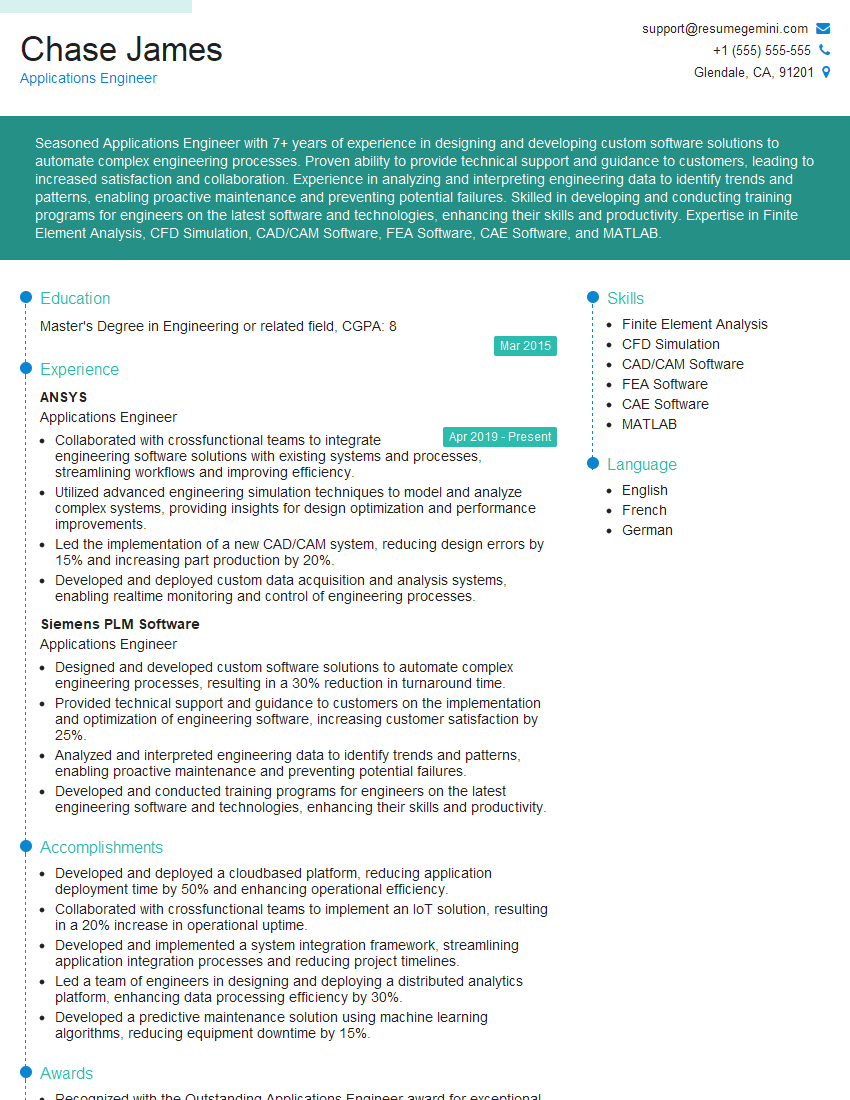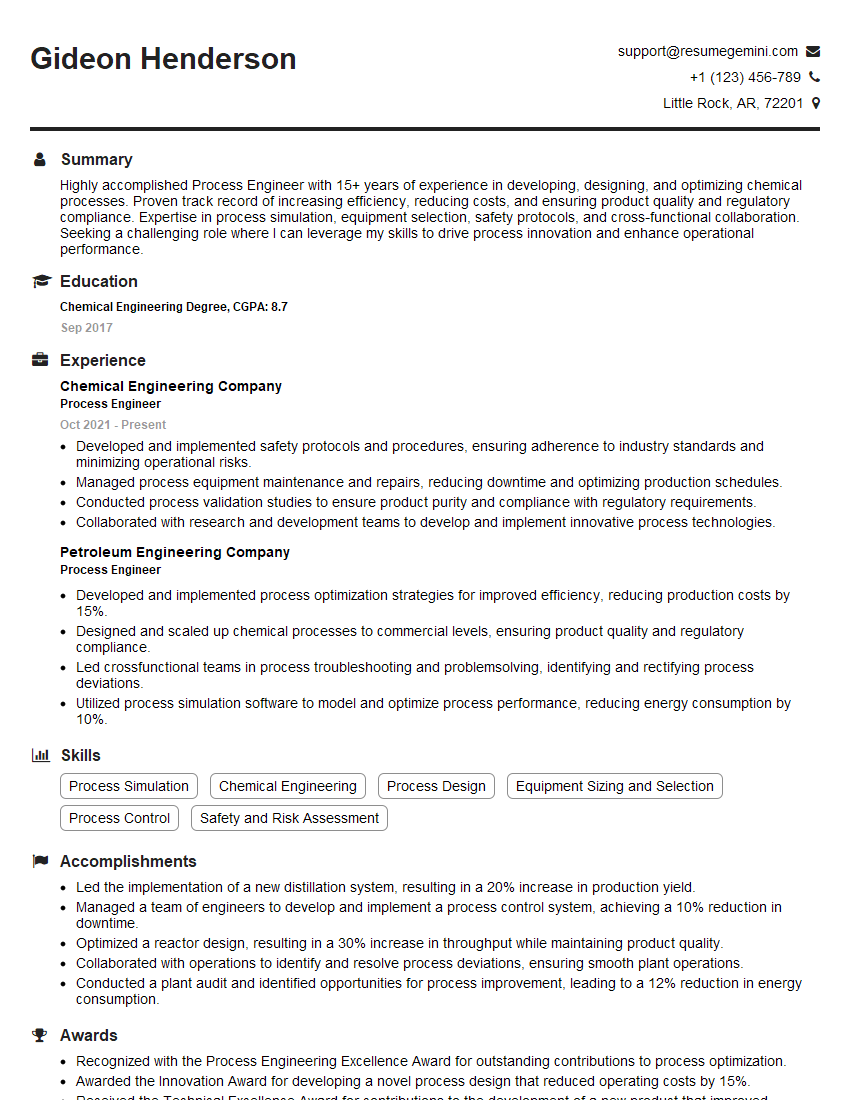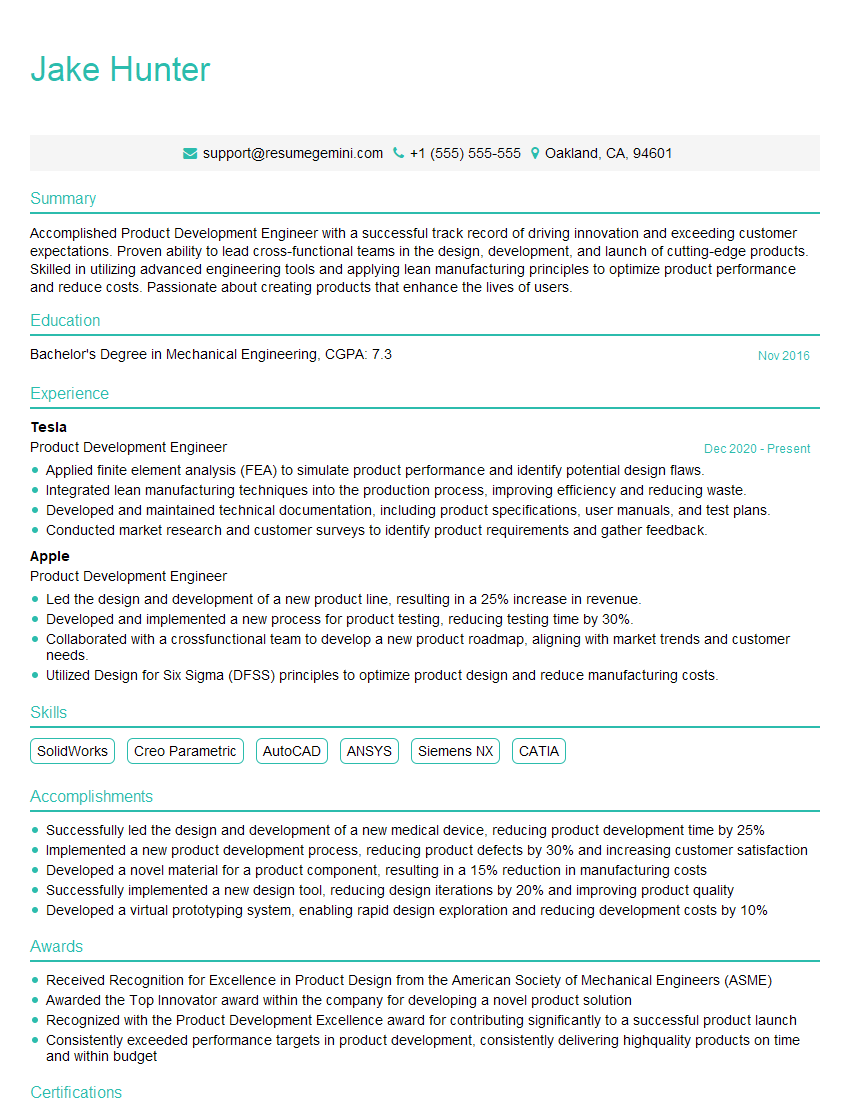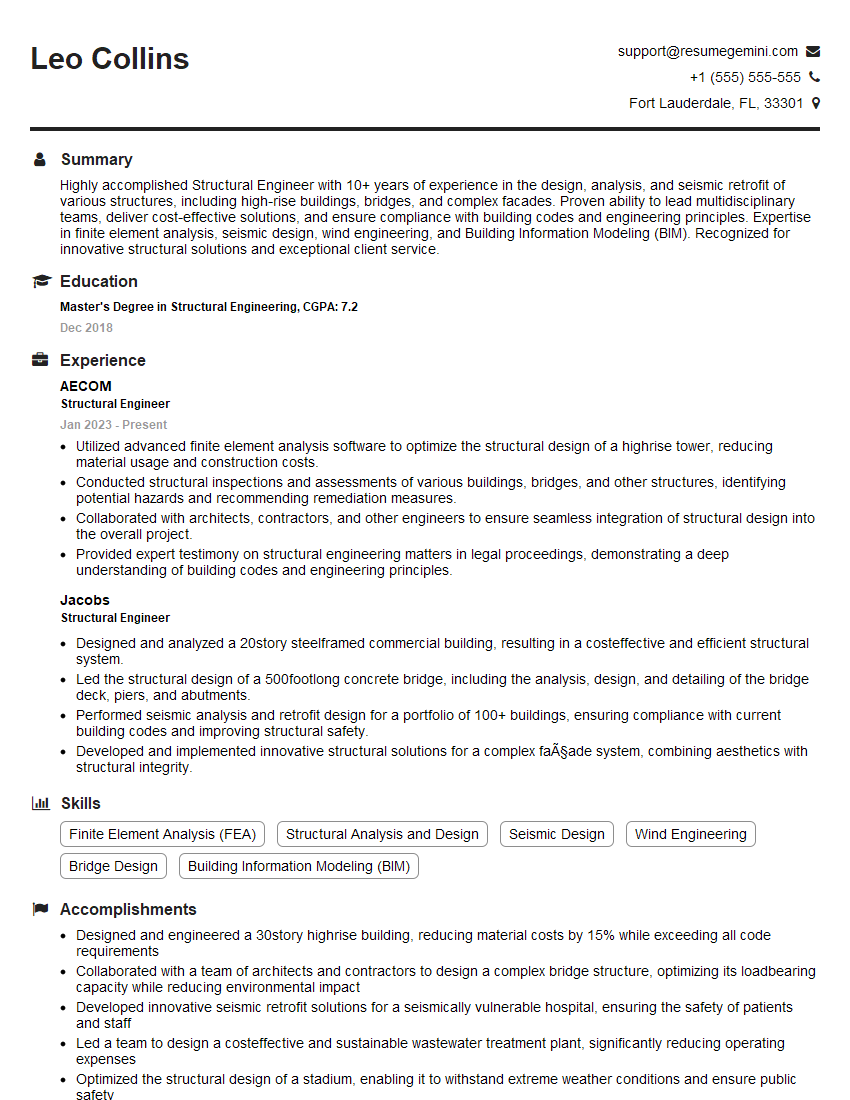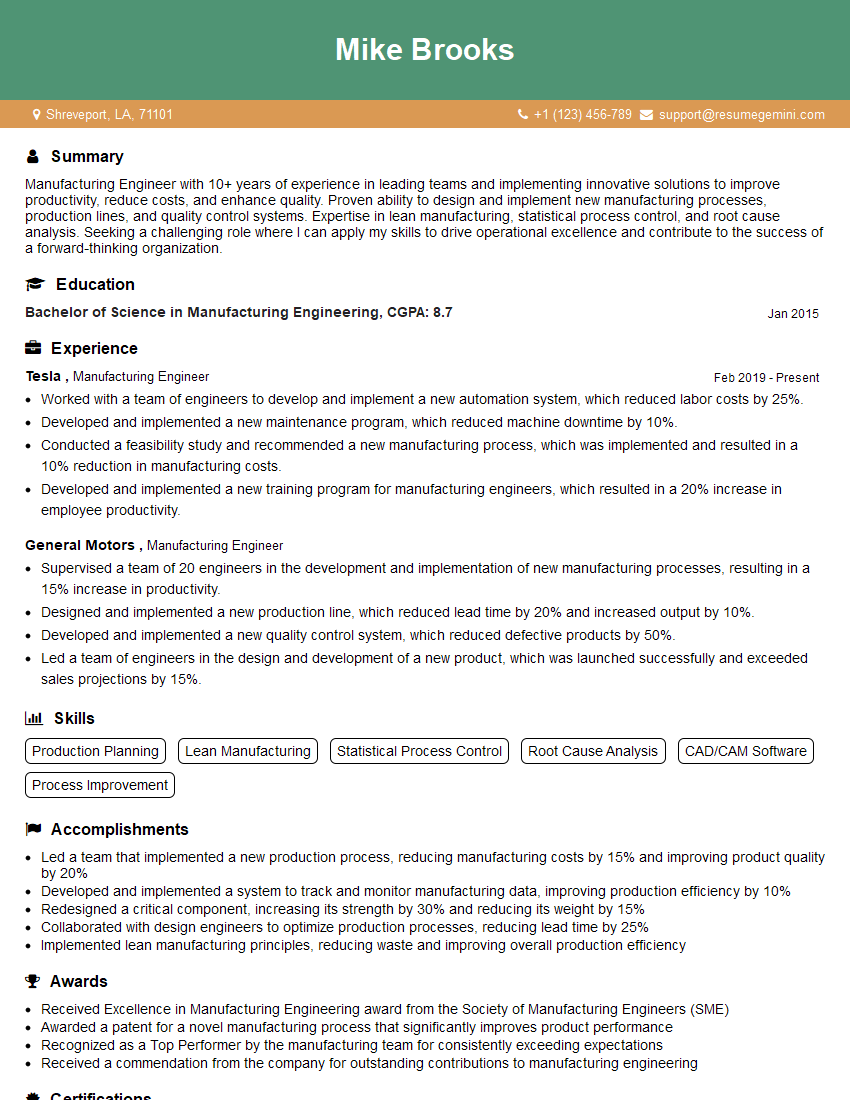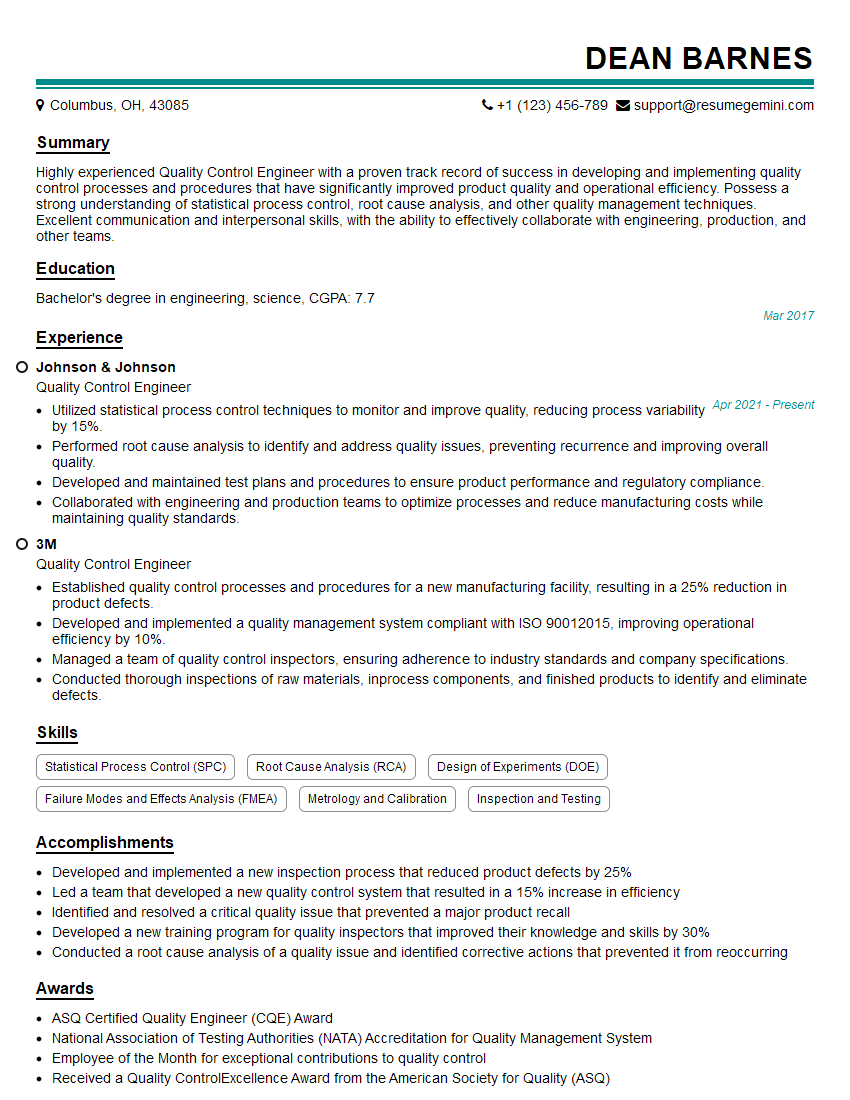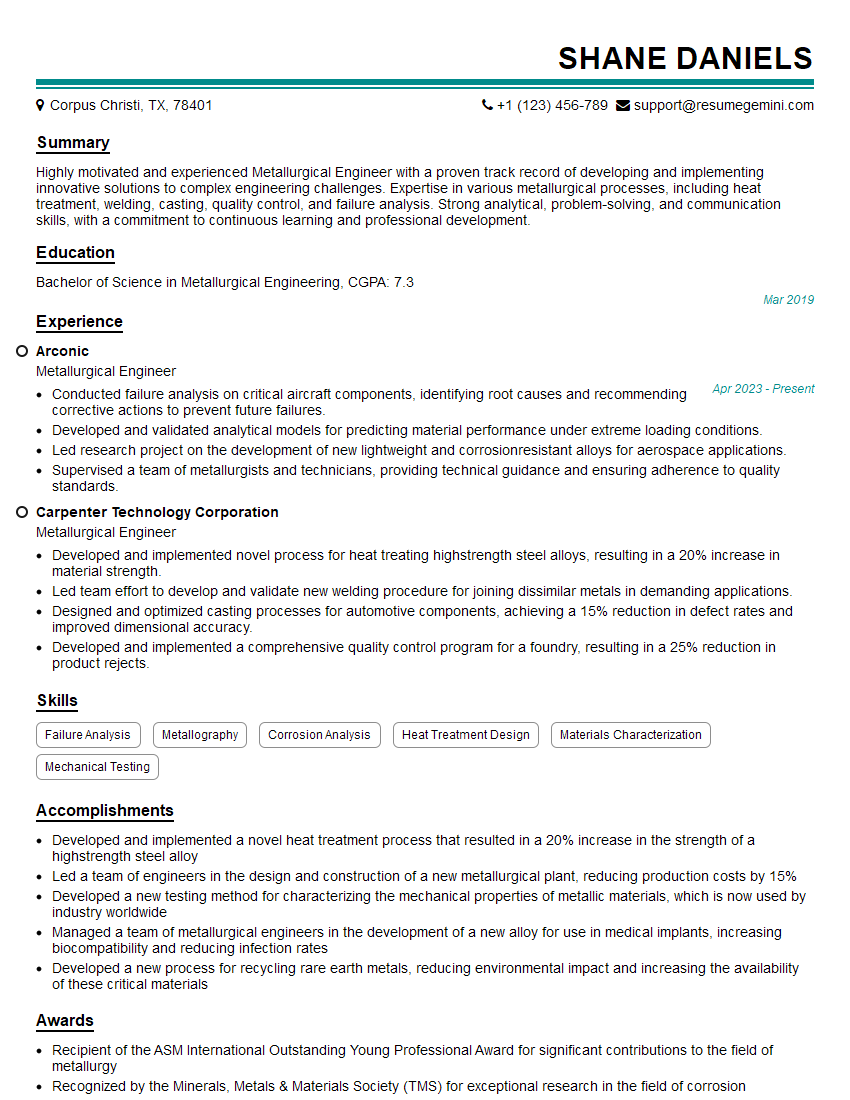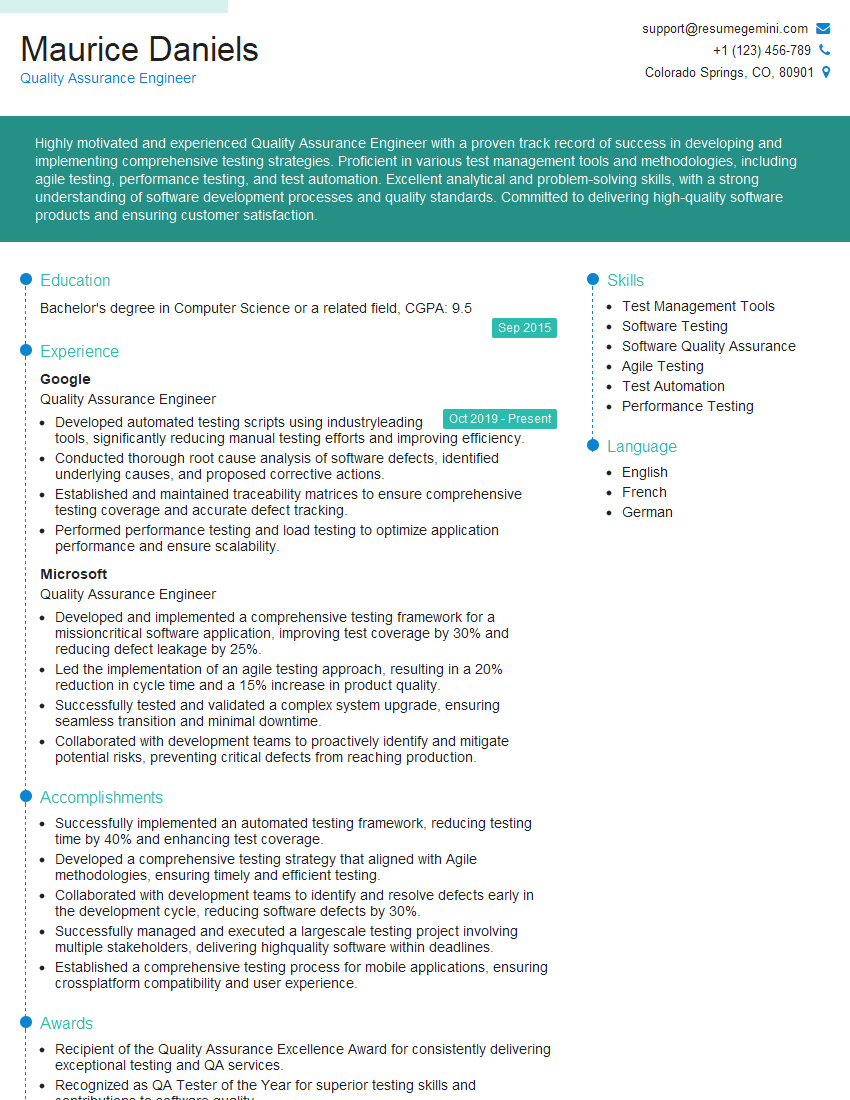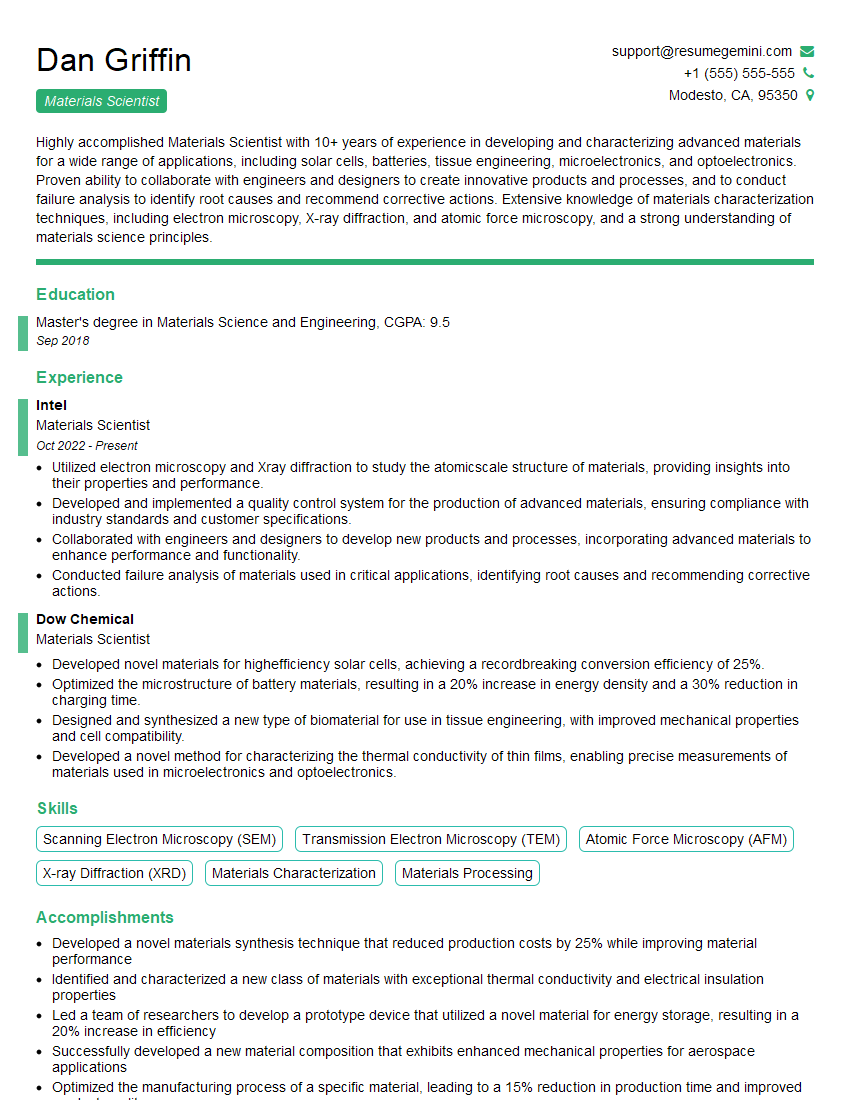Feeling uncertain about what to expect in your upcoming interview? We’ve got you covered! This blog highlights the most important Mechanical Testing (Tensile, Fatigue) interview questions and provides actionable advice to help you stand out as the ideal candidate. Let’s pave the way for your success.
Questions Asked in Mechanical Testing (Tensile, Fatigue) Interview
Q 1. Explain the difference between tensile strength and yield strength.
Tensile strength and yield strength are both crucial measures of a material’s strength, but they represent different aspects of its behavior under tensile loading. Tensile strength represents the maximum stress a material can withstand before it fractures. Think of it as the ultimate breaking point. Yield strength, on the other hand, indicates the stress at which the material begins to deform plastically – meaning the deformation is permanent and won’t recover upon unloading. It’s the point where the material starts to yield or permanently change shape. Imagine stretching a rubber band – it will eventually break (tensile strength), but before that, you’ll notice a point where it starts stretching permanently (yield strength).
For example, a steel bar might have a tensile strength of 500 MPa (megapascals), meaning it will break under a stress greater than that. Its yield strength might be 350 MPa, indicating that permanent deformation begins at this lower stress level. The difference between these two values reflects the material’s ductility – its ability to deform plastically before failure.
Q 2. Describe the stress-strain curve and its significance in tensile testing.
The stress-strain curve is a graphical representation of a material’s response to tensile loading. It plots stress (the force applied per unit area) against strain (the resulting deformation per unit length). This curve is fundamental in tensile testing because it reveals several key material properties.
- Elastic Region: The initial linear portion shows elastic deformation. The material returns to its original shape once the load is removed. The slope of this region represents Young’s Modulus (E), a measure of the material’s stiffness.
- Yield Point: The point where the curve deviates from linearity marks the yield strength. Beyond this point, plastic deformation occurs.
- Ultimate Tensile Strength: The highest point on the curve represents the ultimate tensile strength, the maximum stress the material can withstand before necking (localized reduction in cross-sectional area) and eventual fracture.
- Fracture Point: The end of the curve indicates the fracture point, where the material fails completely.
The shape and characteristics of the stress-strain curve are unique to each material and provide valuable insights into its suitability for various applications. For instance, a material with a high yield strength is ideal for structural components requiring high strength, while a material with high ductility (large plastic deformation before fracture) is better suited for applications needing significant deformation capacity.
Q 3. What are the different types of fatigue failure mechanisms?
Fatigue failure is a progressive and localized structural damage that occurs when a material is subjected to cyclic loading (repeated stress variations). Several mechanisms contribute to fatigue failure:
- Crack Initiation: This is the first stage where microscopic cracks form at stress concentrations, such as surface imperfections or internal flaws. These cracks typically start at regions of high stress.
- Crack Propagation: Once initiated, cracks grow incrementally with each loading cycle. The rate of propagation depends on the stress amplitude, material properties, and environment.
- Final Fracture: The crack continues to propagate until the remaining cross-section is insufficient to support the applied load, leading to catastrophic failure. This often happens suddenly and unexpectedly.
Different types of fatigue mechanisms exist, including:
- High-cycle fatigue: involves many cycles (millions) at relatively low stress levels.
- Low-cycle fatigue: involves fewer cycles (thousands) at high stress levels.
- Corrosion fatigue: occurs when the material is exposed to a corrosive environment during cyclic loading, accelerating the failure process.
- Thermal fatigue: results from repeated thermal cycles causing thermal stresses that lead to crack initiation and propagation.
Understanding these mechanisms is crucial for designing components to withstand fatigue loads.
Q 4. Explain the concept of fatigue limit (endurance limit).
The fatigue limit, also known as the endurance limit, is the maximum stress amplitude a material can withstand for an infinite number of cycles without failing. This limit only applies to certain materials, notably ferrous metals. Non-ferrous materials typically don’t have a true fatigue limit; they eventually fail even under very low stress amplitudes, albeit after a very large number of cycles. Imagine repeatedly bending a paperclip; eventually, it will break, even if you bend it only slightly each time. This illustrates that even low stress amplitudes can accumulate damage over many cycles.
The fatigue limit is a critical design parameter. If a component is expected to undergo millions of cycles, ensuring that the maximum stress amplitude remains below the fatigue limit is crucial for preventing failure. The value of the fatigue limit varies significantly depending on the material, surface finish, and other factors. Determining this limit requires extensive fatigue testing.
Q 5. How do you determine the fatigue life of a material?
Determining the fatigue life of a material involves conducting fatigue tests and analyzing the resulting data. A common approach is to perform S-N (Stress-Number of cycles) testing. In these tests, specimens are subjected to different stress amplitudes and the number of cycles to failure is recorded for each amplitude. The data is then plotted on an S-N curve (log-log scale), which shows the relationship between stress amplitude and the number of cycles to failure.
From this S-N curve, the fatigue life at a specific stress amplitude can be determined by finding the corresponding number of cycles to failure. More sophisticated methods, like strain-life curves, can also be employed for a better prediction of fatigue life, especially for low-cycle fatigue. These methods often rely on statistical analysis to account for material variability and scatter in the data. Predicting the exact fatigue life for any given condition remains a challenge, requiring consideration of various factors including surface finish, temperature, and environment.
Q 6. What are the common methods for conducting fatigue testing?
Several methods exist for conducting fatigue testing, each offering specific advantages and disadvantages:
- Rotating Beam Fatigue Testing: A specimen is rotated while subjected to a bending load. This method is relatively simple and widely used for determining the fatigue strength of materials.
- Axial Fatigue Testing: The specimen is subjected to cyclic axial loading (tension-compression). This method is suitable for studying fatigue behavior under tension and compression loading conditions.
- Torsional Fatigue Testing: The specimen is subjected to cyclic torsional loading (twisting). This is useful for components subjected to torsional stresses.
- Four-point bending fatigue testing: This method ensures constant moment over the gauge section of the specimen, making it ideal for studying pure bending fatigue.
- Random Loading Fatigue Testing: The specimen is subjected to a randomly varying load simulating real-world conditions. This is particularly useful for components experiencing complex loading histories.
The choice of method depends on the specific application and the type of loading the component experiences in service.
Q 7. What are the factors influencing the fatigue strength of a material?
Numerous factors significantly influence the fatigue strength of a material. These can be broadly categorized into material properties, geometric factors, and environmental factors:
- Material Properties: Ultimate tensile strength, yield strength, ductility, and microstructure all play crucial roles. A material’s inherent resistance to crack initiation and propagation dictates its fatigue strength. Higher strength materials generally exhibit higher fatigue strength, although exceptions exist.
- Geometric Factors: Stress concentrations arising from holes, notches, fillets, and surface roughness significantly reduce fatigue strength. Sharp changes in geometry can act as crack initiation sites. The size and shape of the component also influence its fatigue life.
- Environmental Factors: Corrosion, temperature, and humidity all impact fatigue life. Corrosion can accelerate crack propagation, while high temperatures can reduce material strength and alter its microstructure, leading to reduced fatigue resistance.
- Surface Treatments: Shot peening, polishing, and other surface treatments can improve fatigue strength by reducing surface imperfections and introducing beneficial residual stresses.
- Residual stresses: Compressive residual stresses on the surface improve fatigue life, while tensile residual stresses are detrimental.
Careful consideration of these factors during design and material selection is crucial for ensuring component longevity and preventing fatigue failures.
Q 8. Explain the S-N curve and its applications.
The S-N curve, also known as the Wöhler curve, is a graphical representation of the fatigue life of a material. It plots the stress amplitude (S) against the number of cycles to failure (N) under cyclic loading. Essentially, it shows how many times a material can withstand a certain stress level before it breaks due to fatigue.
The curve typically shows a region of high stress with relatively low cycle life (high-cycle fatigue) and a region of low stress with very high cycle life (low-cycle fatigue). The curve’s shape and characteristics are highly material-dependent.
- Applications: S-N curves are crucial in engineering design for predicting the lifespan of components subjected to repetitive loading, such as aircraft wings, bridges, or machine parts. They help engineers determine safe stress limits for a given number of cycles, or conversely, predict the fatigue life under a specific stress level. For example, an engineer designing a bridge would use the S-N curve for the steel used to determine the appropriate safety factor and ensure the bridge can withstand millions of cycles of traffic loading without failing.
- Limitations: Keep in mind that S-N curves are usually generated under controlled laboratory conditions. Real-world factors such as corrosion, temperature variations, and surface imperfections can significantly affect fatigue life and may not be fully captured in the curve.
Q 9. Describe the different types of fatigue loading (e.g., axial, bending, torsional).
Fatigue loading refers to the repeated application of stress below the material’s yield strength, eventually leading to failure. Several types exist, each impacting the material differently:
- Axial Loading: This involves applying a cyclic tensile and compressive force along the longitudinal axis of the specimen. Think of repeatedly pulling and pushing a rod. This type of loading is relatively simple to analyze but may not represent real-world conditions accurately.
- Bending Loading: Here, a cyclic bending moment is applied to the specimen, causing alternating tensile and compressive stresses across its cross-section. A common example is a cantilever beam repeatedly subjected to a load at its free end, like a diving board. This type is common in many engineering applications.
- Torsional Loading: This involves applying a cyclic twisting moment, creating shear stresses within the material. Imagine twisting a shaft back and forth. This is frequent in rotating machinery like shafts and axles.
- Combined Loading: In reality, components often experience a combination of these loading types. Analyzing combined loading is more complex and requires considering stress interactions and superposition principles.
The type of loading significantly affects the fatigue life and the location of failure. For example, bending loading might cause failure on the tensile surface, while torsional loading could lead to failure along a shear plane.
Q 10. How do you choose the appropriate tensile testing standard for a specific material?
Selecting the appropriate tensile testing standard is critical for ensuring consistent and reliable results. The choice depends heavily on the material’s type, form, and intended application. Several widely used standards exist, including ASTM (American Society for Testing and Materials) and ISO (International Organization for Standardization) standards. Here’s a decision-making framework:
- Material Type: Different standards exist for metals, polymers, composites, and ceramics. For instance, ASTM E8 covers the tensile testing of metallic materials, while ASTM D638 focuses on plastics.
- Material Form: Standards vary based on the specimen’s shape (e.g., round bar, flat sheet) and dimensions. The standard must specify the exact dimensions and preparation methods for the test specimen to ensure accuracy.
- Application Requirements: The intended use of the material dictates the relevant mechanical properties that need to be determined. Some standards focus on specific properties like yield strength, ultimate tensile strength, or elongation.
- Industry Regulations: Certain industries might have specific regulatory requirements or preferred standards that must be adhered to.
For example, If you’re testing a steel component for a bridge construction project, you’d likely follow ASTM A370 or a relevant national standard to ensure compliance and structural integrity.
Q 11. What is the significance of Poisson’s ratio in material characterization?
Poisson’s ratio (ν) is a material property that describes the ratio of transverse strain to axial strain when a material is subjected to uniaxial stress. In simpler terms, it indicates how much a material deforms in one direction when stretched or compressed in another. It’s a dimensionless quantity and usually ranges from 0 to 0.5 for most materials.
Significance in Material Characterization: Poisson’s ratio provides valuable insights into the material’s elastic behavior and internal structure. For example, a material with a Poisson’s ratio closer to 0.5 exhibits more incompressible behavior (like rubber), while a material with a lower Poisson’s ratio might be more compressible (like cork). It’s used to determine the bulk modulus from Young’s modulus and helps in developing more accurate constitutive models for material behavior in finite element analysis (FEA).
For instance, understanding a material’s Poisson’s ratio is crucial in designing structures like pressure vessels or seals, where volumetric changes under pressure need precise predictions. A material with an unexpectedly high or low Poisson’s ratio might indicate flaws in its microstructure or processing.
Q 12. Explain the concept of strain hardening (work hardening).
Strain hardening, also known as work hardening, is the phenomenon where a metal becomes stronger and harder as it is deformed plastically. This occurs because the dislocation density within the metal’s crystal structure increases during deformation. These dislocations, which are essentially imperfections in the crystal lattice, impede each other’s movement, making further deformation more difficult.
Mechanism: When a metal is subjected to plastic deformation (beyond its yield point), dislocations are generated and start to move. As they move, they interact with each other, leading to pile-ups and tangles. These interactions increase the resistance to further dislocation movement, resulting in an increase in yield strength and hardness. This strengthening, however, is often accompanied by a reduction in ductility (the material’s ability to deform before fracture).
Practical Applications: This principle is used extensively in metalworking processes like cold rolling, drawing, and forging to enhance the strength and hardness of metal parts. For instance, cold-rolling steel increases its strength significantly, making it suitable for applications requiring high strength.
Q 13. How do you interpret a fracture surface from a fatigue test?
Interpreting a fracture surface from a fatigue test is crucial for understanding the failure mechanism. The surface typically exhibits distinct features that provide clues about the initiation and propagation of cracks. A typical fatigue fracture will show two regions:
- Beach Marks (or Striations): These are concentric ridges visible on the fracture surface, representing the crack propagation during each load cycle. They provide a visual representation of the crack growth rate and the number of cycles to failure. The spacing of these marks can reveal changes in the stress amplitude during the test.
- Fatigue Crack Initiation Site: This is usually the point where the crack initially started. It often has a different texture or appearance compared to the rest of the fracture surface and is typically located at points of stress concentration, such as surface imperfections, notches, or holes.
- Final Fracture Zone: The final fracture is typically brittle and features a rough, irregular texture, occurring after the crack has propagated to a critical size.
By analyzing the characteristics of these features – the size, spacing, and orientation of beach marks, and the location of the initiation site – a material scientist or engineer can determine the cause of fatigue failure, estimate the fatigue life, and suggest improvements in design or material selection. For example, the presence of many beach marks indicates a slow crack growth, which might allow for early detection.
Q 14. What is the role of specimen geometry in tensile and fatigue testing?
Specimen geometry plays a vital role in both tensile and fatigue testing, significantly influencing the accuracy and reliability of the results. The geometry must meet the requirements of the relevant testing standards to ensure consistent and comparable results across different tests.
- Tensile Testing: The standard gauge length (the region where strain is measured) and cross-sectional area are critical. These parameters determine the stress and strain values calculated during the test. Incorrect geometry can lead to inaccurate stress and strain calculations, potentially affecting the determination of material properties like yield strength and ultimate tensile strength. A non-uniform cross-section can cause stress concentration, leading to premature failure.
- Fatigue Testing: Specimen geometry is even more critical due to the potential for stress concentration. Notches, holes, or other geometric discontinuities can significantly reduce fatigue life by acting as crack initiation sites. The shape of the specimen can affect the stress distribution under cyclic loading, influencing the fatigue crack propagation rate. Therefore, the geometry of a fatigue specimen needs meticulous control to obtain reliable results. Common fatigue specimens (e.g., round bars with notches) are carefully designed to introduce controlled stress concentrations for the study of crack initiation and propagation.
In summary, careful selection and preparation of specimens with the correct geometry are essential to obtain meaningful and reliable results in both tensile and fatigue testing. Deviating from standard geometries can introduce significant errors and affect the interpretation of experimental data.
Q 15. How do you address inconsistencies or outliers in test data?
Inconsistencies or outliers in test data are a common challenge in mechanical testing. They can arise from various sources, including errors in specimen preparation, equipment malfunction, or inherent material variability. Addressing them requires a systematic approach.
First, we visually inspect the data for obvious errors. A scatter plot can be particularly helpful. Then, we investigate potential sources of error. Was the testing equipment properly calibrated? Were the specimens prepared consistently? Were there any environmental factors that could have influenced the results (temperature fluctuations, for example)?
Statistical methods are crucial. We might use techniques like Grubbs’ test to identify outliers statistically. If outliers are confirmed to be errors, we can remove them. However, we must justify this removal clearly in our report. If the outliers are deemed to be representative of the material’s true behavior (perhaps indicating a flaw in the material), then we should analyze the implications of their presence and report them honestly. Finally, repeating the test with fresh specimens or improved methodology is vital to ensure reliability and to check for systematic biases.
Imagine testing a batch of steel samples. One sample displays significantly higher tensile strength than the others. Before discarding this data point, we need to check for cracks, impurities, or inaccuracies during the testing procedure. If none are found, this could point to a genuinely stronger specimen within that batch, providing valuable information.
Career Expert Tips:
- Ace those interviews! Prepare effectively by reviewing the Top 50 Most Common Interview Questions on ResumeGemini.
- Navigate your job search with confidence! Explore a wide range of Career Tips on ResumeGemini. Learn about common challenges and recommendations to overcome them.
- Craft the perfect resume! Master the Art of Resume Writing with ResumeGemini’s guide. Showcase your unique qualifications and achievements effectively.
- Don’t miss out on holiday savings! Build your dream resume with ResumeGemini’s ATS optimized templates.
Q 16. Describe different methods for measuring strain (e.g., extensometer, strain gauges).
Strain measurement is fundamental in mechanical testing. Several methods exist, each with strengths and weaknesses:
- Extensometers: These devices directly measure the change in length of a specimen during tensile testing. They provide highly accurate strain readings, especially in the elastic region. There are several types, including clip-on extensometers (attached to the specimen) and contact extensometers (using contact points).
- Strain Gauges: These are small, foil-based sensors bonded to the surface of the specimen. They measure the change in resistance caused by strain, enabling accurate strain measurement. Strain gauges can measure both tensile and compressive strains, and they can be used on complex geometries that are difficult to access with extensometers. Rosettes of strain gauges allow measurement of strain in multiple directions.
The choice of method depends on factors such as accuracy required, the geometry of the specimen, and the testing environment. For example, an extensometer is ideal for precise measurements in a standard tensile test, whereas a strain gauge is more suitable for measuring strain in curved or irregularly shaped specimens or under complex stress states. Furthermore, strain gauges are more suitable for fatigue testing and other dynamic applications.
Q 17. What are the limitations of tensile and fatigue testing?
Tensile and fatigue testing, while powerful techniques, have limitations:
- Tensile Testing: Tensile testing primarily focuses on the material’s response to monotonic loading (a load that increases steadily). It does not directly reveal behavior under cyclic loading, which is crucial for many applications. Furthermore, it may not fully capture the material’s behavior in real-world scenarios, where loads may be multiaxial or impacted by environmental factors.
- Fatigue Testing: Fatigue testing, while examining cyclic loading, is expensive and time-consuming. It can be challenging to accurately represent real-world loading scenarios in the lab. The results may be affected by the test’s specific setup, such as loading frequency, waveform, and stress ratios. Also, it may be difficult to extrapolate fatigue life data from lab tests to real-world conditions, particularly with complex loading histories.
It’s important to remember that both tests offer idealized scenarios. Real-world components often experience complex load histories and environmental conditions that are difficult to perfectly replicate in the lab. Hence, we often use a combination of testing methods and modelling to gain a comprehensive understanding of a material’s behaviour.
Q 18. How do temperature and environment affect material properties in testing?
Temperature and environment significantly influence material properties in mechanical testing. Temperature affects the material’s strength, ductility, and stiffness, frequently impacting yield strength, ultimate tensile strength, and elongation. High temperatures generally reduce yield strength and increase ductility, while low temperatures can have the opposite effect. Think of the change in the flexibility of rubber at different temperatures; hot rubber is flexible and cold rubber is brittle.
The environment can also play a significant role, particularly for corrosion-susceptible materials. Moisture, chemicals, and other environmental factors can affect the material’s properties by causing corrosion, oxidation, or other forms of degradation. For instance, a metal exposed to salt spray during testing will show different behavior than a metal tested in a controlled environment. Therefore, environmental control is crucial when simulating real-world conditions accurately.
In many tests, the testing machine is equipped with a temperature chamber allowing for testing at different temperatures. This allows us to understand the material’s behaviour under various conditions, critical for applications where materials face temperature extremes, such as aerospace or automotive.
Q 19. Explain the concept of creep and its influence on material properties.
Creep is the time-dependent deformation of a material under constant stress and elevated temperature. Imagine a metal wire under constant tension; over time, it will slowly elongate even if the load remains unchanged. This slow deformation is creep.
Creep’s influence on material properties is significant because it can lead to structural failure even under stresses lower than the material’s yield strength. The rate of creep increases with increasing temperature and stress. Three stages of creep are generally observed: primary (decreasing creep rate), secondary (constant creep rate), and tertiary (accelerating creep rate leading to failure).
Understanding creep is crucial for designing components operating at high temperatures, such as turbine blades in jet engines or pressure vessels in power plants. Designers need to consider the creep characteristics of the materials to ensure the components can withstand the anticipated loading and temperatures over their intended service life, otherwise, creep may lead to structural instability and failure.
Q 20. What is the difference between static and dynamic fatigue testing?
The difference between static and dynamic fatigue testing lies in the rate at which the load is applied and the nature of the loading cycle.
- Static fatigue testing involves subjecting the material to a constant load over an extended period. This is typically used to study the effects of slow crack growth or stress corrosion cracking.
- Dynamic fatigue testing, also known as cyclic fatigue testing, involves applying a cyclic load (repeated loading and unloading) to the material. This test is done to determine the material’s resistance to failure under repetitive stress. The testing parameters include the number of cycles to failure (fatigue life), the stress amplitude, and the mean stress. Different waveforms such as sinusoidal, square, triangular and random can also be applied.
For example, static fatigue testing might be used to evaluate the lifespan of a fiber optic cable under constant tension, while dynamic fatigue testing would be more suitable for assessing the durability of a bridge component subjected to traffic-induced vibrations.
Q 21. Describe different types of extensometers and their applications.
Extensometers come in various types, each tailored for specific applications:
- Clip-on Extensometers: These are readily attached to the specimen and are suitable for most standard tensile tests. They are relatively inexpensive and easy to use, and offer good accuracy, particularly for standard gauge lengths.
- Contact Extensometers: These use contact points to measure the elongation of the specimen. They offer high accuracy, particularly for measuring small strains, and are sometimes used for tests at high temperatures.
- Video Extensometers: These use digital image correlation to measure strain. This method is non-contact, enabling strain measurement on rough or complex surfaces, and offers high spatial resolution.
- Strain Gauges (as extensometers): While primarily considered separate, bonded strain gauges can also be used to measure strain. They are particularly useful for complex geometries or when many strain measurements are needed. Multiple gauges placed in a rosette can show strain in multiple directions.
The selection depends on several factors. Clip-on extensometers are common in routine tests, while video extensometers are suitable for specimens with complex shapes. Contact extensometers are a good choice when high accuracy is required even at high temperatures.
Q 22. How do you ensure the accuracy and precision of your testing procedures?
Ensuring accuracy and precision in mechanical testing is paramount. It involves a multi-faceted approach, starting with meticulous sample preparation. We must ensure representative samples are selected, carefully machined to precise dimensions, and free from surface defects that could introduce errors. This often involves using techniques like polishing and etching, and careful visual inspection with magnification.
Calibration is critical. All testing equipment, from the extensometer measuring strain to the load cell measuring force, must be rigorously calibrated against traceable standards. This involves regular checks against certified weights and gauges, and documented procedures that ensure traceability to national or international standards. Frequency of calibration depends on usage and manufacturer recommendations but is typically done at least annually.
Furthermore, environmental control plays a significant role. Temperature and humidity can influence material properties, leading to inaccurate results. Maintaining a controlled environment within the testing machine is essential, and the test parameters themselves should be recorded diligently and checked against the material’s specifications.
Finally, proper operator training and adherence to standardized testing procedures are fundamental. This reduces the influence of human error and ensures consistent results. We use documented Standard Operating Procedures (SOPs) and regularly review and update them as needed based on experience and evolving best practices. This holistic approach ensures confidence in our test results.
Q 23. Explain the concept of stress concentration and its impact on fatigue life.
Stress concentration refers to the localized increase in stress around geometric discontinuities in a component, such as holes, notches, fillets, or changes in cross-section. Imagine a piece of paper – if you make a small cut, the paper tears easily at that point even if you are not applying a lot of overall force. That’s because the stress concentrates at the tip of the cut.
In fatigue testing, stress concentration significantly reduces the fatigue life of a component. The higher localized stresses exceed the material’s endurance limit much earlier than the nominal stress would, leading to crack initiation and propagation at these points. The severity of stress concentration depends on the geometry of the discontinuity and is often quantified using stress concentration factors (Kt).
For instance, a small hole in a tensile specimen significantly reduces its fatigue life compared to a specimen without a hole. The design of components should always consider minimizing stress concentrations through appropriate geometric features and smooth transitions. Fatigue analysis often involves finite element analysis (FEA) to simulate stress distribution and accurately predict fatigue life considering these stress concentrations.
Q 24. What are common data analysis techniques used in mechanical testing?
Data analysis in mechanical testing involves a range of techniques, depending on the type of test and the information sought. For tensile testing, basic analysis focuses on determining the yield strength, ultimate tensile strength, and elongation using the stress-strain curve. We plot the engineering stress versus engineering strain. We also examine the fracture surface for evidence of ductile or brittle failure. This helps identify any flaws within the material or the testing procedure.
For fatigue testing, the analysis is more complex. We often use techniques like S-N curves (stress versus number of cycles to failure) to determine the fatigue strength and fatigue life. Statistical analysis, such as Weibull analysis, helps model the distribution of fatigue lives and account for the inherent variability in material properties. Linear regression can be applied to fit curves to data, allowing for prediction of failure lives under specific stress conditions.
Beyond these, more advanced techniques such as fracture mechanics can be employed to examine crack growth rates and predict the remaining life of a component with pre-existing defects. Digital Image Correlation (DIC) is becoming increasingly popular, allowing for high-resolution measurement of strain fields across the entire specimen during testing, improving data quality and leading to better insights.
Q 25. How do you use statistical methods to analyze fatigue data?
Statistical methods are crucial for analyzing fatigue data due to its inherent variability. Fatigue life is not a deterministic property; even identical specimens subjected to the same loading will exhibit a range of failure lives. Therefore, we cannot use simple averages.
Weibull distribution is commonly used to model the distribution of fatigue lives. This statistical distribution accounts for the variability and provides parameters that characterize the fatigue performance (shape and scale parameters). This allows us to make probabilistic statements about the fatigue life, such as predicting the life at a certain probability of failure. This approach moves beyond simply knowing the average fatigue life to understanding the entire distribution of potential lives.
Regression analysis, particularly linear regression, is useful for fitting S-N curves to experimental data and making predictions of fatigue life under different stress levels. We fit a line (linear regression) through the data points to define an equation which can then be used to predict failure at any point along the line. The coefficient of determination, R², indicates how well the data fits the proposed line.
Furthermore, statistical hypothesis testing can be used to compare the fatigue performance of different materials or to determine whether changes in processing or design have a significant impact on fatigue life. It’s vital to remember that the quality of the statistical analysis depends significantly on the quality and quantity of the experimental data.
Q 26. Describe your experience with different types of testing machines.
My experience encompasses a range of testing machines, from universal testing machines (UTMs) for tensile and compression testing to specialized fatigue testing machines. I’ve worked extensively with servo-hydraulic UTMs capable of applying both static and dynamic loads with precise control over load rate and displacement. These are excellent for various tests involving tension, compression, bending, and shear. I’m familiar with both screw-driven and hydraulic actuators, understanding their respective advantages and limitations. For fatigue testing, I’ve used both resonant fatigue testing machines (for high-cycle fatigue) and servo-hydraulic fatigue testers (for low-cycle fatigue) capable of controlling complex load profiles.
I have also worked with specialized equipment such as extensometers for accurate strain measurement, which are often crucial for advanced analyses. I’m proficient in using data acquisition systems to record load, displacement, strain, and other relevant parameters during testing. Understanding the capabilities and limitations of these machines, including their calibration and maintenance requirements, is paramount for obtaining reliable test data. This extends to specialized equipment for specialized tests like creep testing and impact testing.
Q 27. How do you ensure the safety of yourself and others during mechanical testing?
Safety is always the top priority in mechanical testing. This begins with a thorough risk assessment before any testing commences. We identify potential hazards such as component failure, high-speed projectiles from broken specimens, and exposure to high loads or stresses. Appropriate safety measures are then implemented based on the identified risks.
This includes the use of safety guards on testing machines to prevent access to hazardous areas. We always use appropriate Personal Protective Equipment (PPE), such as safety glasses, gloves, and hearing protection. Additionally, we ensure that the testing environment is well-organized and free of tripping hazards. Proper training for all personnel involved, emphasizing safe operating procedures, is crucial.
Emergency procedures are clearly defined and practiced regularly. This includes knowing the location of emergency shut-off switches and having a plan for dealing with potential accidents. Regular equipment inspections and maintenance are conducted to ensure that all safety features are functioning correctly. The use of safety interlocks and emergency stops is strictly enforced. All these steps ensure a safe working environment and minimize the risk of accidents.
Q 28. Explain your experience with interpreting and reporting test results.
Interpreting and reporting test results requires careful consideration. It involves not only analyzing the raw data but also understanding the context of the test and the implications of the findings. For tensile testing, I interpret the stress-strain curve to determine mechanical properties such as yield strength, ultimate tensile strength, elongation, and modulus of elasticity. I also analyze the fracture surface to understand the failure mechanism – was it ductile or brittle? This can provide valuable clues about material quality and processing.
For fatigue testing, I analyze the S-N curves and associated statistical parameters to determine the fatigue strength and fatigue life. Understanding the limitations of fatigue data and the inherent variability is crucial. Reports must clearly communicate the uncertainty associated with fatigue life predictions. Furthermore, I correlate fatigue data with material microstructure and other relevant factors to provide comprehensive interpretations. I then prepare detailed reports using standardized formats that are both technically accurate and readily comprehensible to both technical and non-technical audiences. Reports are clear, concise, and visually appealing, utilizing graphs and tables to effectively communicate the results and their implications. This is vital for making well-informed decisions in design and manufacturing.
Key Topics to Learn for Mechanical Testing (Tensile, Fatigue) Interview
- Stress-Strain Curves and Material Properties: Understand the behavior of materials under tensile loading, including yield strength, ultimate tensile strength, ductility, and modulus of elasticity. Explore how these properties are determined from experimental data and their significance in material selection.
- Tensile Testing Procedures and Standards: Familiarize yourself with ASTM standards and other relevant testing procedures. Understand the importance of proper specimen preparation, machine calibration, and data acquisition for accurate and reliable results.
- Fatigue Failure Mechanisms: Learn about different fatigue failure mechanisms, including crack initiation, propagation, and final fracture. Understand the role of stress concentration, surface finish, and environmental factors.
- Fatigue Testing Methods: Become familiar with various fatigue testing methods, such as constant amplitude fatigue testing (CA), fatigue crack growth testing, and variable amplitude fatigue testing (VA). Understand the limitations and applications of each method.
- S-N Curves and Fatigue Life Prediction: Learn how to interpret S-N curves and understand the concept of fatigue life prediction. Explore different methods for estimating fatigue life under various loading conditions.
- Fracture Mechanics: Gain a basic understanding of fracture mechanics concepts, such as stress intensity factors and crack growth rates. This knowledge is crucial for analyzing fatigue crack propagation.
- Data Analysis and Interpretation: Master the techniques for analyzing experimental data obtained from tensile and fatigue tests. This includes understanding statistical methods and error analysis.
- Practical Applications: Consider real-world examples of how tensile and fatigue testing are used in various industries, such as aerospace, automotive, and biomedical engineering. This will help you connect theoretical concepts to practical applications.
- Problem-Solving Approaches: Practice solving problems related to material selection, fatigue life prediction, and failure analysis. This will demonstrate your ability to apply your knowledge to real-world scenarios.
Next Steps
Mastering mechanical testing, specifically tensile and fatigue testing, is crucial for a successful career in engineering. A strong understanding of these concepts is highly sought after by employers and significantly enhances your problem-solving capabilities and overall technical expertise. To maximize your job prospects, crafting an ATS-friendly resume is essential. ResumeGemini is a trusted resource that can help you build a professional and impactful resume, increasing your chances of landing your dream job. Examples of resumes tailored to Mechanical Testing (Tensile, Fatigue) roles are available to guide you.
Explore more articles
Users Rating of Our Blogs
Share Your Experience
We value your feedback! Please rate our content and share your thoughts (optional).
What Readers Say About Our Blog
Hi, I have something for you and recorded a quick Loom video to show the kind of value I can bring to you.
Even if we don’t work together, I’m confident you’ll take away something valuable and learn a few new ideas.
Here’s the link: https://bit.ly/loom-video-daniel
Would love your thoughts after watching!
– Daniel
This was kind of a unique content I found around the specialized skills. Very helpful questions and good detailed answers.
Very Helpful blog, thank you Interviewgemini team.

